Hypothesis Testing
MPA 6010
Ani Ruhil
Agenda
The Logic of Hypothesis Testing
One-tailed versus Two-tailed hypotheses
One-Sample t-tests
Two-group t-tests
Paired t-tests
Assumptions of t-tests
The Logic of Hypothesis Testing
Hypothesis testing is an inferential procedure that uses sample data to evaluate the credibility of a specific belief about a population parameter. The process involves ...
Stating a
hypothesis:an assumption that can neither be fully proven nor fully disproven. For example,Not more than 5% of GM trucks breakdown in under 10,000 miles
Heights of North American adult males is distributed with μ=72 inches
Mean year-round temperature in Athens (OH) is ≥62
10% of Ohio teachers are Accomplished
Mean county unemployment rate in Ohio is 4.1%
Drawing a sample to test the hypothesis
Conducting the test itself to see if the hypothesis should be rejected
The Null and the Alternative Hypotheses
Null Hypothesis (H0): is the assumption believed to be true
Alternative Hypothesis (H1): is the statement believed to be true if H0 is rejected
H0: μ>72 inches; H1: μ≤72
H0: μ<72 inches; H1: μ≥72
H0: μ≤72 inches; H1: μ>72
H0: μ≥72 inches; H1: μ<72
H0: μ=72 inches; H1: μ≠72
H0 and H1 are mutually exclusive and mutually exhaustive
Mutually Exclusive: Either H0 or H1 is True ⋯ both cannot be true at the same time
Mutually Exhaustive: H0 and H1 exhaust the Sample Space ⋯; there are no other possibilities that could exist that we are unaware of
Type I and Type II Errors
Decision based on Sample |
Null is true |
Null is false |
|---|---|---|
| Reject the Null | Type I error | No error |
| Do not reject the Null | No error | Type II error |
Type I Error: Rejecting the Null hypothesis H0 when H0 is true
i.e., we should not have rejected the Null hypothesis
| Decision | H0 is True | H0 is False |
|---|---|---|
| Reject H0 | Type I error (α) | No error (1−β) |
| Do not reject H0 | No error (1−α) | Type II error (β) |
Type II Error: Failing to reject the Null hypothesis H0 when H0 is false
i.e., we should have rejected the Null hypothesis
The probability of committing a Type I error = Level of Significance =α
We have to decide how often we are okay with committing a Type I error (i.e., falsely Reject H0). Conventionally Type I error rate is set to one of the following α values: α=0.05 or α=0.01
Note the very cautious language ... Reject H0 versus Do Not Reject H0
The Process of Hypothesis Testing: An Example
Historically, the standard pediatric vaccination schedule — covering diphtheria–tetanus–pertussis (DTaP), polio, Haemophilus influenzae type b (Hib), measles–mumps–rubella (MMR), pneumococcal, plus hepatitis B — became widely normalized and accepted as standard criteria for children to attend public schools in the late 20th century.
During the COVID-19 pandemic folk began wondering if vaccine hesitancy would explode to such an extent that more parent would start asking for vaccine exemptions for their children. Has this happened in Ohio? Are indeed more children attending kindergarten exempt from vaccines? Regardless of what we believe, perhaps the Governor would like us to carry out a test and see if exemptions have grown. How would we test this?
The first thing would be a starting point -- what was the exemption rate in 2018-19? Records show the rate was 2.9%. Now we can write our hypotheses.
H0:Exemption rates are the same or lower (μ0≤2.9)
Since we are expected to test if exemption rates have grown the alternative hypothesis would be:
H1:Exemption rates have increased (μ0>2.9)
The Sampling Distribution of ˉx
We know from the theory of sampling distributions that the distribution of sample means, for all samples of size n, will be normally distributed (as shown below)
Most samples would be in the middle of the distribution but by sheer chance we could end up with a sample mean in the tails. This will happen with a very small probability but it could happen!!
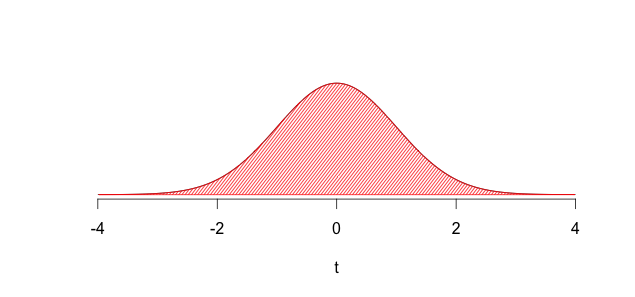
For example, we could get a sample mean that when converted into its t−score via t=ˉx−μsˉx, with the standard error is given by sˉx=s√n could assume values of t=±∞ Here are some t values the probability of seeing them with a sample size of 300 (i.e., n=300) and hence df=n−1=300−1=299.
Calculate the probabilities of each shaded region.
Calculate the probabilities of each shaded region.
Calculate the probabilities of each shaded region.
If sample means can fall anywhere in the distribution with varying probabilities, we have to establish some probability cutoff such that if the probability of drawing our sample mean meets or surpasses that cutoff we can say there is a very low probability of this occurring if H0 is true and hence it must be that exemptions have increased.
Conventionally we set this cutoff to be probabilities of 0.05 and 0.01, respectively. These are the areas shaded in green below:
We run an anonymous survey of public schools and out of a total of 300 responses (n=300), we see the average exemption rate to be 4.7% and a standard deviation of (s=0.212).
What is the t−score here?
First, the standard error sˉx=s√n=0.212√300=0.0122
Second, the t−score calculated as t=ˉx−μ0sˉx=4.7−2.90.0122=1.80.0122=147.541
If nothing has changed and in reality in the population of kindergarteners only 2.9% are exempt, the probability of ending up with t=147.541 is practically 0 ... aka, highly unlikely to occur by chance.
Hence the only logical conclusion is to say, well, we reject the null hypothesis that exemption rates are 2.9% or less.
Formally, we set the following decision rules:
- Reject the Null hypothesis if the probability of your calculated t is ≤α
- Do not reject the Null hypothesis if the probability of your calculated t is >α
α=0.05 or α=0.01
Critical Region vs Region of "Acceptance"
Region of Acceptance
Critical Region
But what if we had no specific guidance and wanted to simply test whether exemption rates have changed? Now we would have to allow our calculated t−score to be positive or negative.
H0:Exemption rates are 2.9% (μ0=2.9) H1:Exemption rates are not 2.9% (μ0≠2.9)
The process revisited ...
State the hypotheses
- If we want to test whether something has
changedthen H0 must specify that nothing has changed …H0:μ=μ0;H1:μ≠μ0… two-tailed - If we want to test whether something is
differentthen H0 must specify that nothing is different …H0:μ=μ0;H1:μ≠μ0… two-tailed - If we want to test whether something had an
impactthen H0 must specify that it had no impact …H0:μ=μ0;H1:μ≠μ0… two-tailed - If we want to test whether something has
increasedthen H0 must specify that it has not increased …H0:μ≤μ0;H1:μ>μ0… one-tailed - If we want to test whether something has
decreasedthen H0 must specify that it has not decreased …H0:μ≥μ0;H1:μ<μ0… one-tailed
- If we want to test whether something has
Collect the sample and set α=0.05 or α=0.01
- Calculate sˉx=s√n, ˉx, df=n−1, and then t
- Reject H0 if calculated t falls in the critical region; do not reject H0 otherwise. This is the same as saying Reject H0 if p-value is ≤α; do not reject H0 if p-value >α
Problem 1
Last year, Normal (IL) the city's motor pool maintained the city's fleet of vehicles at an average cost of 346 per car. This year Jack's Crash Shop is doing the maintenance. City notices that in a random sample of 36 cars fixed by Jack the mean repair cost is 330 with a standard deviation of 120. Is Jack's Crash Shop saving the City money?
H0:μ≥346 and H1:μ<346. Let us choose α=0.05. Note df=n−1=36−1=35
sˉx=s√n=120√36=20, and hence t=ˉx−μ0sˉx=330−34620=−1620=−0.80
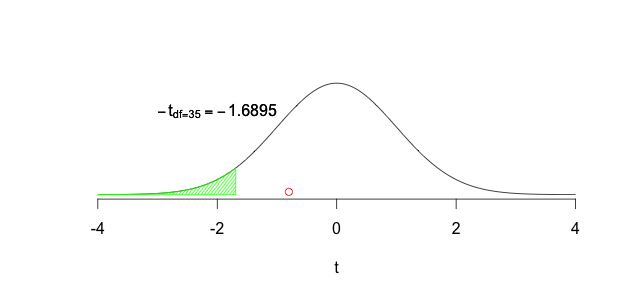
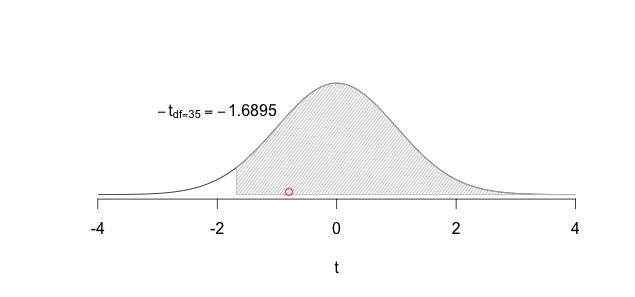
Fail to reject H0; the data suggest that Jack's prices may not differ from those predicted by the null hypothesis
Problem 2
Kramer's (TX) Police Chief learns that his staff clear 46.2% of all burglaries in the city. She wants to benchmark their performance and to do this she samples 10 other similar cities in Texas. She finds their numbers to be as follows:
| Rate | Rate |
|---|---|
| 44.2 | 32.1 |
| 40.3 | 32.9 |
| 36.4 | 29.0 |
| 49.4 | 46.4 |
| 51.7 | 41.0 |
Is Kramer's clearance rate significantly different from those of other similar Texas cities?
H0:μ=46.2 and H1:μ≠46.2. Set α=0.05
Note df=n−1=10−1=9, ˉx=40.34, and sˉx=2.4279
t=ˉx−μ0sˉx=40.34−46.22.4279=−2.414
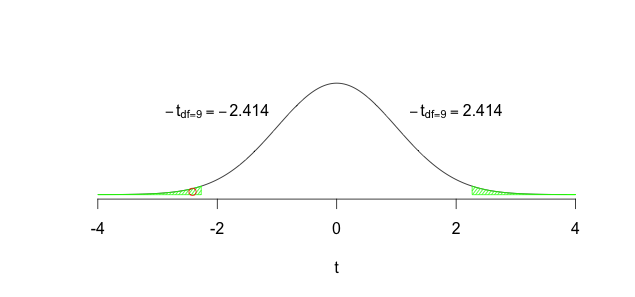
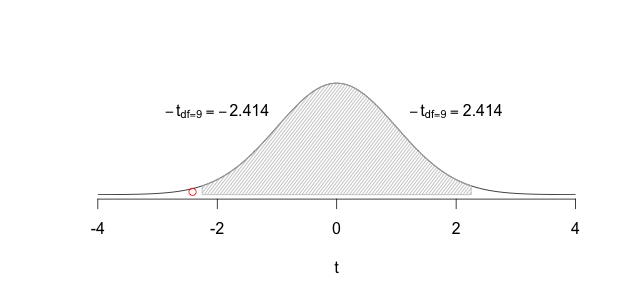
Reject H0; the data suggest that Kramer's clearance rate does not conform with that of other similar Texas cities.
Problem 3: Philanthropy
The Director of Philanthropy at the Fleckman Institute of the Arts is curious to assess the impact of this year's changes in federal tax laws on donations. Last year the average donation was 580. A random sample of 50 donors yields an average donation of 623.64 with a standard deviation of 84.27. Did the change in federal tax laws have an impact on donations? … solve this on your own
Problem 4: Volunteering
Springdale University is concerned that student volunteer activity has decreased. Last year their students volunteered an average of 7.3 hours of community service per month. This year, a random sample of 75 student volunteers reveals an average of 7.07 hours per month with a standard deviation of 1.29 hours. Should the University be concerned? … solve this on your own
Overlap Between Hypothesis Tests and Confidence Intervals
Calculate the 95% confidence interval for a sample mean ˉx
Note that in this confidence interval, α=0.05; α/2=0.025
Use the Test Statistic with α=0.05 to make a decision
Note the similarity?
Assumptions Underlying the t−test
The data are independent within the sample and identically distributed
- no clustering,
- no serial dependence,
- design quirks that tie observations together
The t−statistic is approximately normally distributed
The model is correctly specified
- observations come from a population with a constant mean (the parameter you test),
- there is finite variance
- and measurements are unbiased and on a continuous scale
Testing Assumptions?
Check your data sampling plan, the study design, and measurement
Visual checks for Normality (Histograms, boxplots, QQ-plots)
Formal tests of Normality
Small n: lean on Shapiro–Wilk (H0: Data come from a Normally distributed population) and QQ Plots; be wary of outliers.
Medium n (30–200): CLT helps; emphasize QQ Plots and tail fit.
Large n: tiny deviations will always “fail” tests; trust visual diagnostics and robustness.
If you see curved QQ lines, that is skew; S-shaped is heavy/light tails. Fix with transformations only if they clarify interpretation; otherwise prefer robust inference.
QQ Data (qqplot-data.sav)
| Theoretical Values | Sample Values |
|---|---|
| 7.20 | 7.47 |
| 8.24 | 8.63 |
| 8.90 | 8.88 |
| 9.43 | 9.11 |
| 9.92 | 9.54 |
| 10.38 | 10.14 |
| 10.87 | 10.26 |
| 11.40 | 10.92 |
| 12.06 | 13.12 |
| 13.10 | 13.43 |
QQ Plots that hint at Non-Normality
QQ Plots that hint at Normality
Shapiro-Wilk Test and QQ Plot for Kramer (TX)
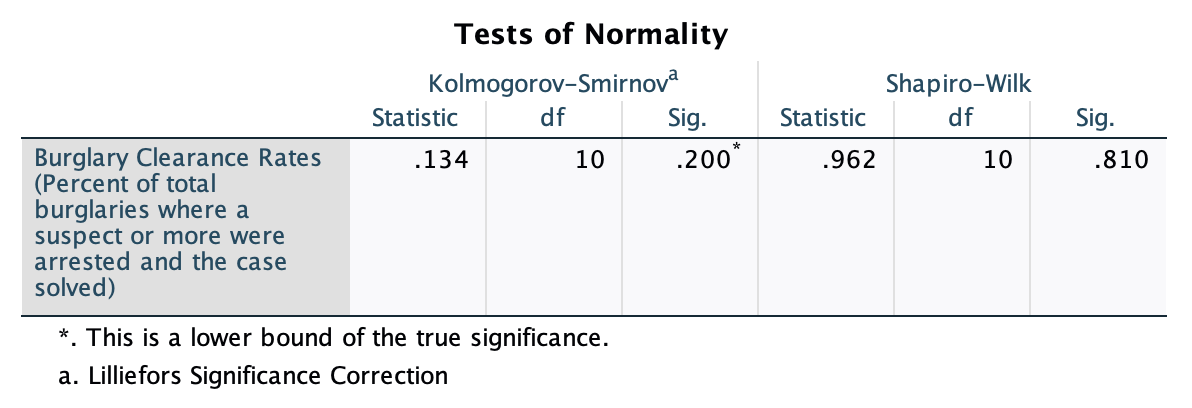
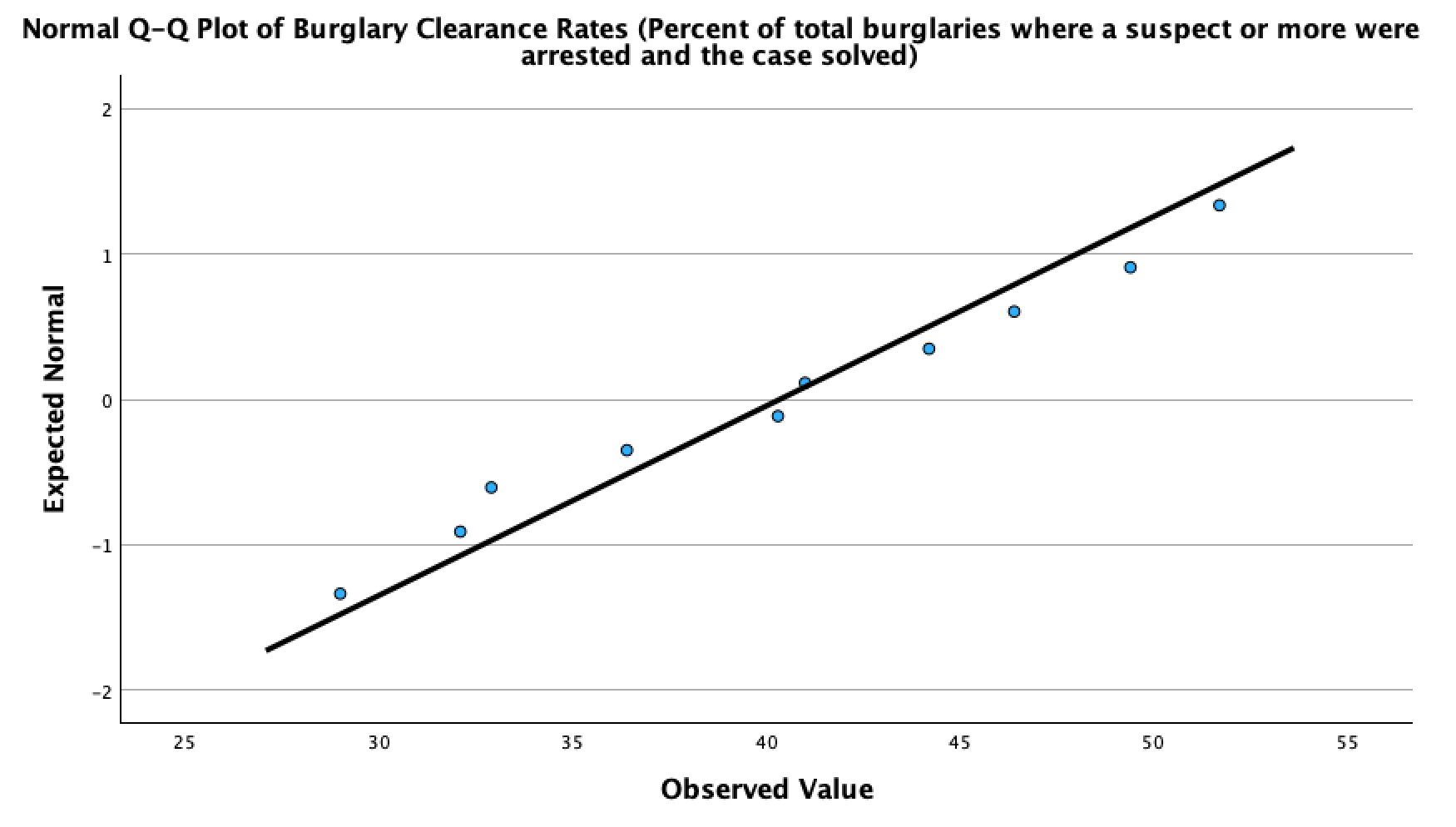
Beware of Normality Tests
p−value=0.00008903; Reject H0
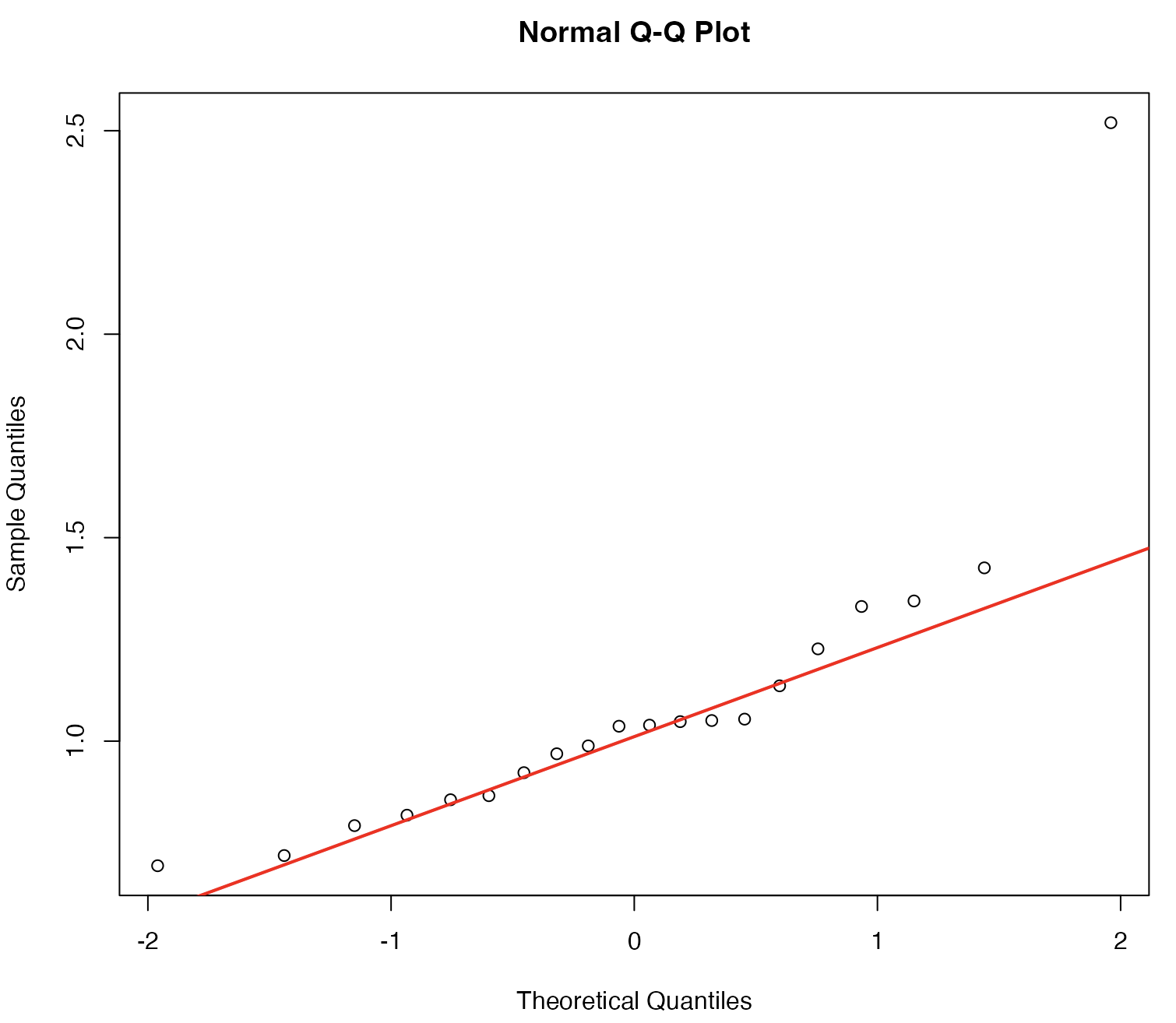
p−value=0.2015; Do not Reject H0
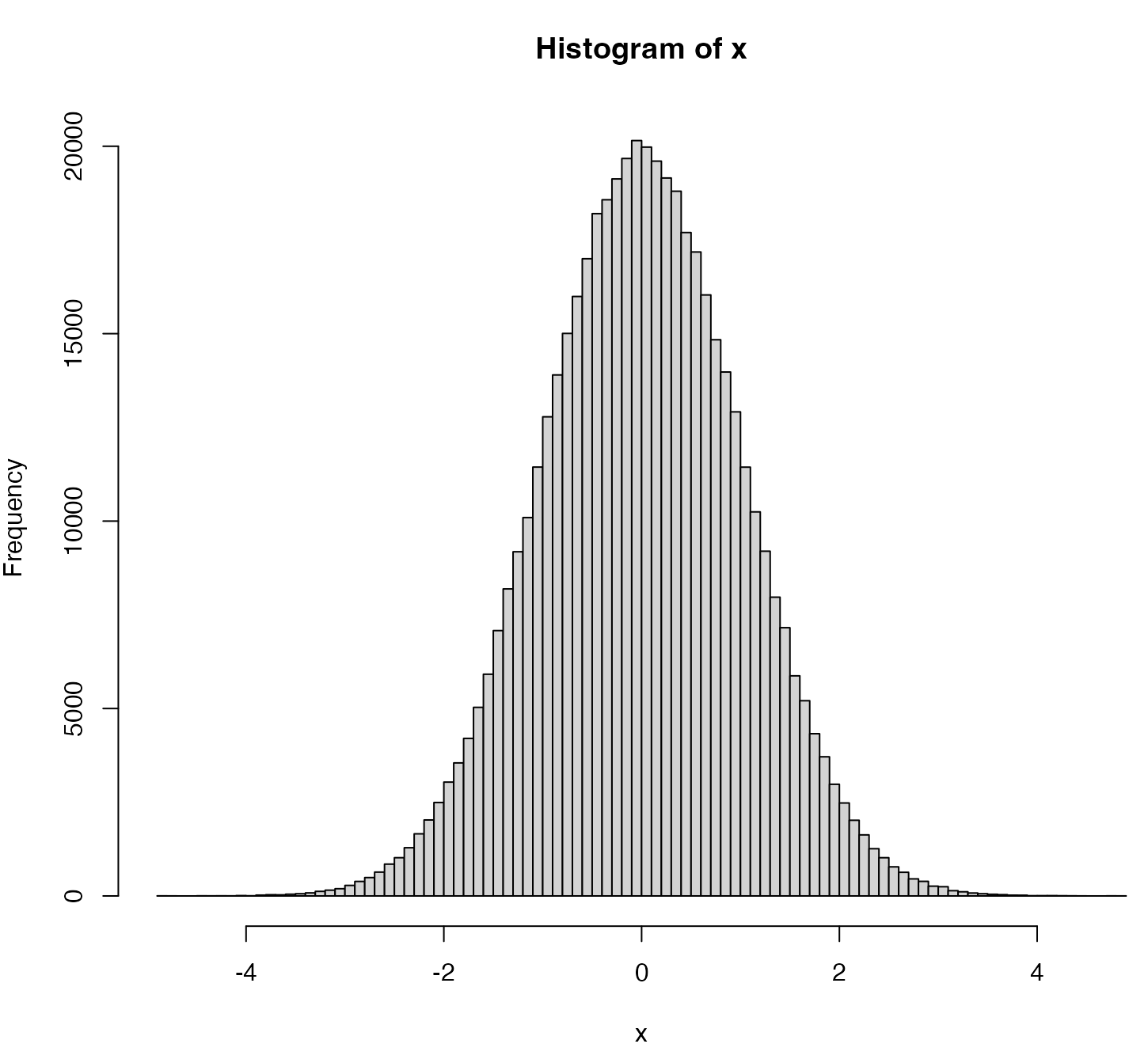
What should I do if my data are Non-Normal?
Consider eliminating outliers and then redo tests
Consider transforming your data, starting with taking z-scores, for example
Right‑skewed, positive data: try square root, log, or Box–Cox, in that order. Add a small constant only when zeros exist.
Proportions near 0 or 1: use logit on bounded rates, or arcsine‑sqrt for binomial proportions; stabilize variance before modeling. [Outside the scope of this course]
Left‑skewed: reflect then apply a right‑skew fix (e.g., transform y=max(x)−x, then take the log or the sqrt of y).
Heavy tails: consider rank‑based or robust methods instead of forcing normality; Huberization or winsorizing only if defensible. [Outside the scope of this course]
Multiplicative errors: log typically linearizes relationships and equalizes spread. [Outside the scope of this course]
Switch to non-parametric statistical tests
Right-Skewed Example (right-skewed-data.sav)
Open data in SPSS
Look at key descriptive statistics and plots to see if there is any skew and if there is, is the measure right-skewed or left-skewed
Note: For skewness, now you have ...
H0: The data are not skewed (i.e., s=0);
H1: The data are skewed (i.e., s≠0)
- If they are right-skewed then we need to transform the data via ...
(a) Take the logarithm of the skewed variable
(b) Take the square-root of the skewed variable
If your data include 0 values you need to add a very small constant, perhaps k=0.5, before you take the logarithm or the square-root
Check the key descriptive statistics and plots of the transformed variables to see if there is any skew.
If skewness persists, then try another transformation or switch to non-parametric tests
Left-Skewed Example (left-skewed-data.sav)
Open data in SPSS
Look at key descriptive statistics and plots to see if there is any skew and if there is, is the measure right-skewed or left-skewed
Note: For skewness, now you have ...
H0: The data are not skewed (i.e., s=0);
H1: The data are skewed (i.e., s≠0)
- If they are left-skewed then we need to transform the data via ...
(a) Create a right-skewed version via y1=max(x1)−x1) and then take the logarithm of the skewed variable, and if this does not work,
(b) Create a right-skewed version via y1=max(x1)−x1) and then take the square-root of the skewed variable
If your data include 0 values you need to add a very small constant, perhaps k=0.5, before you take the logarithm or the square-root
Check the key descriptive statistics and plots of the transformed variables to see if there is any skew.
If skewness persists, then try another transformation or switch to non-parametric tests
Non-Parametric Tests
Non-parametric tests are used
(a) when transformations do not work, or
(b) the data represent ordinal categories (or are ranked data)Called non-parametric because unlike, say, the t −test which requires some distributional assumption to be true (i.e., Normality) and involves parameters (i.e., the mean and the variance), these alternatives make no such assumptions and need no such parameters
They are more likely to lead to a Type II error so if the assumptions of parametric tests are met use parametric tests
The Sign & Wilcoxon Signed-Rank Tests (length-of-stay-data.sav)
- Assumption: Random sample from a continuous distribution
- Tests whether the Median equals a hypothesized value (the H0 value)
- Scores above H0 value are marked +; scores below are marked -
- Scores = to the Median are dropped
- If H0 is correct, 50% of the scores should be “+” and 50% should be “-” ... essentially a Binomial test where p0=0.5
H0: Distribution is symmetric around p0=0.5
H1: Distribution is not symmetric around p0≠0.5
- A very weak test so use the Wilcoxon Signed-Rank Test if you need a non-parametric test
Sign Test: Analyze > Nonparametric Tests > Legacy Dialogs > Binomial...
Wilcoxon Signed-Rank Test: Analyze > Nonparametric Tests > One Sample...For the Wilcoxon Signed-Rank Test you will have H0: The median of your variable is some value, i.e., H0:Md=Md0, for example, in our case, we could use H0:Md=5 or whatever you think is the median length of stay
Comparing Two Means
Comparisons of Means from Common Parent Population
Common Parent Population
Comparisons of Means from Different Parent Populations
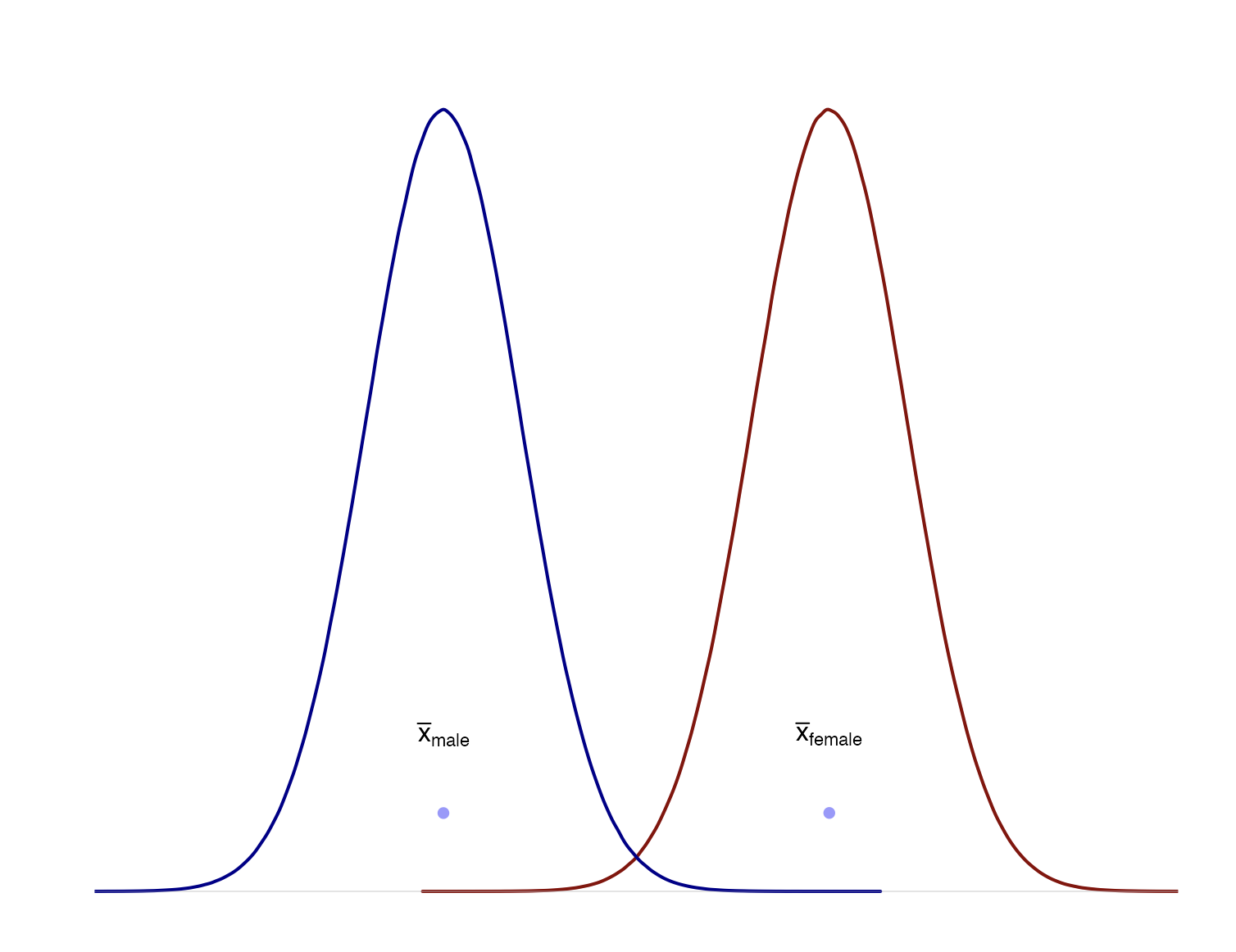
Separate Parent Populations
We often need to compare sample means across two groups. For example, are average earnings the same for men and women in a specific occupation? Perhaps we suspect (a) women are underpaid or (generally) that (b) their salaries differ from those of men.
Let the population and sample means be μm,μw and ˉxm,ˉxw, respectively
(a) H0:μm≤μw and H1:μm>μw, ∴H0:μm−μw≤0 and H1:μm−μw>0
(b) H0:μm=μw and H1:μm≠μw, ∴H0:μm−μw=0 and H1:μm−μw≠0
Standard Error of the difference in means: sˉxm−ˉxw=√s2mnm+s2wnw
Confidence Interval estimate: (ˉxm−ˉxw)±tα/2(sˉxm−ˉxw)
The Test Statistic: t=(ˉxm−ˉxw)−(μm−μw)√s2mnm+s2wnw=(ˉxm−ˉxw)−D0√s2mnm+s2wnw
The degrees of freedom for this test: df=(s2mnm+s2wnw)21(nm−1)(s2mnm)2+1(nw−1)(s2wnw)2
Note: We usually round down the df to the nearest integer
We have two ways of calculating the estimated standard error (sˉx1−ˉx2) and the degrees of freedom df
(1) When the population variances are assumed unequal
(2) When the population variances are assumed equal
(1) Unequal Population Variances
Standard Error will be: (sˉx1−ˉx2)=√σ21n1+σ22n2
Degrees of Freedom will be: df=(s2mnm+s2wnw)21(nm−1)(s2mnm)2+1(nw−1)(s2wnw)2
Rule of thumb ...
Use this when n1 or n2 are <30 and
Either sample has a standard deviation at least twice that of the other sample
(2) Equal Population Variances
Standard Error will be: (sˉx1−ˉx2)=√n1+n2n1×n2√(n1−1)s2x1+(n2−1)s2x2(n1+n2)−2
Degrees of Freedom will be: df=(n1+n2)−2
Rule of thumb ...
Use this when the standard deviations are roughly equal, and
n1 and n2 ≥30
Assumptions and Rules-of-thumb
Assumptions:
(1) Random samples representing each group, drawn from the population(s)
(2) Variables are drawn from normally distributed Populations
Rules-of-thumb:
Draw larger samples if you suspect the Population(s) may be skewed
Go with assumption of
equal variancesif both the following are met:
(a) Assumption theoretically justified, standard deviations fairly close, &
(b) n1≥30 and n2≥30Go with assumption of
unequal variancesif both the following are met:
(a) One standard deviation is at least twice the other standard deviation, &
(b) n1<30 or n2<30
Of course, some statistical software packages (SPSS, for instance) will run the test under both assumptions so you can choose on the basis of the results (a bad idea in some eyes)
Testing Variances: Levene's Test for Homogeneity of Variances
- Assumes roughly symmetric frequency distributions within all groups
- Robust to violations of assumption
- Can be used with 2 or more groups
H0:σ21=σ22=σ23=⋯σ2k and HA: For at least one pair of (i,j) we have σ2i≠σ2j
Test Statistic: W=(N−k)k∑i=1ni(ˉZi−ˉZ)2(k−1)k∑i=1ni∑j=1(Zij−ˉZi)2
Zij=|Yij−ˉYi|; ˉZi is the mean for all Y in the ith group; ˉZ is the mean for all Y in the study; k is the number of groups in the study; and ni is the sample size for group i
If you opt for the more robust version that uses the Median, then, Zij=|Yij−˜Yi| where ˜Yi is median of ith group
W∼Fα,k−1,n−k
Example 1
The Athens County Public Library is trying to keep its bookmobile alive since it reaches readers who otherwise may not use the library. One of the library employees decides to conduct an experiment, running advertisements in 50 areas served by the bookmobile and not running advertisements in 50 other areas also served by the bookmobile. After one month, circulation counts of books are calculated and mean circulation counts are found to be 526 books for the advertisement group with a standard deviation of 125 books and 475 books for the non-advertisement group with a standard deviation of 115 books. Is there a statistically significant difference in mean book circulation between the two groups?
| Group | Mean | Std. Dev. | Sample Size |
|---|---|---|---|
| Advertisement Group | 526 | 125 | 50 |
| Non-Advertisement Group | 475 | 115 | 50 |
Since we are being asked to test for a "difference" it is a two-tailed test, with hypotheses given by:
H0: There is no difference in average circulation counts (μ1=μ2)H1: There is a difference in average circulation counts (μ1≠μ2)
Since both groups have sample sizes that exceed 30 we can proceed with the assumption of equal variances and calculate the standard error and the degrees of freedom. The degrees of freedom as easy: df=n1+n2−2=50+50−2=98. The standard error is sˉx1−ˉx2=√n1+n2n1n2√(n1−1)s2x1+(n2−1)s2x2(n1+n2)−2 and plugging in the values we have
sˉx1−ˉx2=√50+502500√(50−1)(1252)+(50−1)(1152)(50+50)−2=(0.2)(120.1041)=24.02082
The test statistic is
t=(ˉx1−ˉx2)−(μ1−μ2)sˉx1−ˉx2=(526−475)−024.02082=5124.02082=2.123158
Since no α is given let us use the conventional starting point of α=0.05
With df=98 and α=0.05, two-tailed, the critical t value would be ±1.98446745
Since our calculated t=2.1231 exceeds the critical t=1.9844, we can easily reject the null hypothesis of no difference
Conclusion: These data suggest there is a difference in average circulation counts between the advertisement and no advertisement groups
We could have also used the the p-value approach, rejecting the null hypothesis of no difference if the p-value was ≤α
The p-value of our calculate t turns out to be 0.0363 and so we can reject the null hypothesis
Note, in passing, that had we used α=0.01 we would have been unable top reject the null hypothesis because 0.0363 is >0.01
The 95% confidence interval is given by
(ˉx1−ˉx2)±tα/2(sˉx1−ˉx2)=51±1.9844(24.02082)=51±47.66692=3.33308 and 98.66692
We can be about 95% confident that the true difference between the groups lies in this interval
Had we used the 99% interval for a test with α=0.01 the interval would be
51±2.627(24.02082)=−12.10269 and 114.1027
subsuming the null hypothesis difference of 0 and leaving us unable to reject the null hypothesis.
Example 2 (mtcars-data.sav)
Say we have a large data-set with a variety of information about several cars, gathered in 1974. One of the questions we have been tasked with testing is whether the miles per gallon yield of manual transmission cars in 1974 was greater than that of automatic transmission cars. Assume they want us to use α=0.05.
We have 13 manual transmission cars and 19 automatic transmission cars, and the means and standard deviations are 24.3923 and 6.1665 for manual, and 17.1473 and 3.8339 for automatic cars, respectively. The hypotheses are:
H0:Mean mpg of manual cars is at most that of the mean mpg of automatic cars (ˉxmanual≤ˉxautomatic)H1:Mean mpg of manual cars is greater than mean mpg of automatic cars (ˉxmanual>ˉxautomatic)
| Group | ni | ˉxi | si |
|---|---|---|---|
| Manual | 13 | 24.3923 | 6.1665 |
| Automatic | 19 | 17.1473 | 3.8339 |
The calculated t is 4.1061 and the p-value is 0.0001425, allowing us to reject the null hypothesis
Conclusion: These data suggest that average mpg of automatic cars is not at most that of manual cars
Note a couple of things here:
(i) We have a one-tailed hypothesis test, and
(ii) we are assuming unequal variances since both conditions are not met for assuming equal variances
In addition, note that the confidence interval is found to be (3.6415,10.8483), indicating that we can be 95% confident that the average manual mpg is higher than average automatic mpg by anywhere between 3.64 mpg and 10.84 mpg
SPSS Example 01 (TN Project STAR data)
Carry out a test for whether there is a difference in reading scores of male versus female kindergarteners
Run the appropriate tests of assumptions, stating your conclusions
Conduct the t-test assuming equal variances and assuming unequal variances
What do you conclude?
Carry out a test for whether there is a difference in reading scores of third graders in regular classrooms vs small classrooms
Run the appropriate tests of assumptions, stating your conclusions
Conduct the t-test assuming equal variances and assuming unequal variances
What do you conclude?
SPSS Example 02 (Ohio Schools Data)
Carry out a test for whether there is a difference in the average Performance Index score of public versus charter schools
Run the appropriate tests of assumptions, stating your conclusions
Conduct the t-test assuming equal variances and assuming unequal variances
What do you conclude?
Identify the Median percent economically disadvantaged and then construct a new variable that takes on the value of 0 if the school's percentage is at or below this Median, and 1 if above. Label the values accordingly.
Now test whether the average Performance Index score of schools at or below the Median (in terms of economic disadvantage) is lower than that of schools above the Median
Run the appropriate tests of assumptions, stating your conclusions
Conduct the t-test assuming equal variances and assuming unequal variances
What do you conclude?
Nonparametric Test (Mann-Whitney U Test) assuming equal variances
The assumptions of the Mann-Whitney U test are:
- The variable of interest is continuous (not discrete). The measurement scale is at least ordinal
- The probability distributions of the two populations are identical, except for location (i.e., the “center”)
- The two samples are independent
- Both are simple random samples from their respective populations
H0: The samples come from populations with similar probability distributions
Test Process and Statistic ...
- Combine both samples and rank, in ascending order, all values, and if there are ties, rank accordingly
- Sum the ranks of the smaller group (R1)
- U1=n1n2+n1(n1+1)2−R1; U2=n1n2−U1
- Choose the larger of U1 or U2 as the test statistic
Analyze > Nonparametric Tests > Legacy Dialogs > 2 Independent Samples, choose Mann–Whitney U
Nonparametric Test (Kolmogorov-Smirnov Test) assuming unequal variances
This (very weak) test is used to compare the distributions of two groups by comparing the empirical cumulative distribution functions (ecdfs) of the two groups and finding the greatest absolute distance between the two
The ecd f is Fˆ(Y) = fraction of sample with values ≤Yi, where i=1,2,3,⋯,n
The K−S statistic is Dmax=|Fˆ1(Y)−Fˆ2(Y)|
Assumptions:
- The measurement scale is at least ordinal.
- The probability distributions are continuous
- The two samples are mutually independent
- Both samples are simple random samples from their respective populations
H0:F1(Y)=F2(Y) for all Yi.
H1:F1(Y)≠F2(Y) for at least one Yi.Analyze > Nonparametric Tests > Legacy Dialogs > 2 Independent Samples
Comparing Matched or Paired Means
Matched (aka Dependent or Paired) Samples
Sometimes you may have two sets of measures on the same units. Now
- H0:μd=0;H1:μd≠0 or
- H0:μd≥0;H1:μd<0 or
- H0:μd≤0;H1:μd>0
ˉd=∑din
sd=√∑(di−ˉd)2n−1 and sˉd=sd√n
Test Statistic: t=ˉd−μdsˉd
With normally distributed population df=n−1
Interval estimate: ˉd±tα/2(sˉd)
The Testing Protocol
Let us see how the test is carried out with reference to a small data-set wherein we have six pre-school children's scores on a vocabulary test before a reading program is introduced into the pre-school (x2) and then again after the reading program has been in place for a few months (x2).
| Child ID | Post-intervention score | Pre-intervention score | Difference = Post - Pre |
|---|---|---|---|
| 1 | 6.0 | 5.4 | 0.6 |
| 2 | 5.0 | 5.2 | -0.2 |
| 3 | 7.0 | 6.5 | 0.5 |
| 4 | 6.2 | 5.9 | 0.3 |
| 5 | 6.0 | 6.0 | 0.0 |
| 6 | 6.4 | 5.8 | 0.6 |
Note the column di has the difference of the scores such that for Child 1, 6.0−5.4=0.6, for Child 2, 5.0−5.2=−0.2, and so on.
Note also that the mean, variance and standard deviation of d are calculated as follows:
di=x1−x2ˉd=∑dins2d=∑(di−ˉd)2n−1sd=√∑(di−ˉd)2n−1
Say we have no idea what to expect from the program. In that case, our hypotheses would be:
H0:μd=0H1:μd≠0
The test statistic is given by t=ˉd−μdsd/√n;df=n−1 and the interval estimate calculated as ˉd±tα/2(sd√n).
Once we have specified our hypotheses, selected α, and calculated the test statistic, the usual decision rules apply: ...
- Reject the null hypothesis if the calculated p−value≤α
- Do not reject the null hypothesis if the calculated p−value>α
In this particular example, it turns out that ˉd=0.30; sd=0.335; t=2.1958, df=5, p−value=0.07952 and 95% CI: 0.3±0.35=(−0.0512,0.6512).
Given the large p−value we fail to reject H0 and conclude that these data do not suggest a statistically significant impact of the reading program.
Example 3
Over the last decade, has poverty worsened in Ohio's public school districts? One way to test worsening poverty would be to compare the percent of children living below the poverty line in each school district across two time points. For the sake of convenience I will use two American Community Survey (ACS) data sets that measure Children Characteristics (Table S0901), one the 2011-2015 ACS and the other the 2006-2010 ACS. While a small snippet of the data are shown below for the 35 school districts with data for both years, you can download the full dataset from here.
| District | 2006-2010 | 2011-2015 |
|---|---|---|
| Akron City School District, Ohio | 35.3 | 41.0 |
| Brunswick City School District, Ohio | 6.8 | 7.6 |
| Canton City School District, Ohio | 44.1 | 49.6 |
| Centerville City School District, Ohio | 10.5 | 5.4 |
| Cincinnati City School District, Ohio | 39.5 | 43.0 |
| Cleveland Municipal School District, Ohio | 45.8 | 53.3 |
H0: Poverty has not worsened (d≤0)H1: Poverty has worsened (d>0)
Subtracting the 2006-2010 poverty rate from the 2011-2015 poverty rate for each district and then calculating the average difference (d) yields ˉd=4.328571 and sd=3.876746
With n=35 we have a standard error sˉd=sd√n=3.876746√35=0.6552897
The test statistic is t=ˉdsˉd=4.3285710.6552897=6.605584 and has a p−value=0.0000001424, allowing us to easily reject the null hypothesis
... These data suggest that school district poverty has indeed worsened over the intervening time period. The 95% confidence interval is (2.9968 and 5.6602)
Example 4
A large urban school district in a Midwestern state implemented a reading intervention to boost the district's scores on the state's English Language Arts test. The intervention was motivated by poor performance of the district's 4th grade cohort. Three years had passed before that cohort was tested in the 8th grade. Did the intervention boost ELA scores, on average?
| Student ID | Grade | Scaled Score |
|---|---|---|
| AA0000001 | 3 | 583 |
| AA0000002 | 3 | 583 |
| AA0000003 | 3 | 583 |
| AA0000004 | 3 | 668 |
| AA0000005 | 3 | 627 |
| AA0000006 | 3 | 617 |
H0: Intervention did not boost ELA scores (d≤0)H1: Intervention did boost ELA scores (d>0)
We have ˉd=14.62594, sd=66.27296, df=12955 and the standard error is 0.5822609
The test statistic then is t=ˉdsˉd=14.625940.5822609=25.11922 and has a p−value that is very close to 0 and obviously way smaller than α=0.05 and α=0.01
Hence we can reject the null hypothesis; these data suggest that the reading intervention did indeed boost English Language Arts scores on average.
Testing Options and the Protocol
Data are coming from a paired design, use the two-sample t−test for paired samples
Data are coming from two unpaired groups, use the two-sample t−test with
- the assumption of equal variances if n1≥30 and n2≥30 and s1≈s2
- the assumption of unequal variances if n1<30 or n2<30 and si≥2(sj)
Use Levene's test for homogeneity of variances if the assumption of normality is not supported
Normality is not as big a deal since these tests are robust to small violations of normality, provided you have "large enough samples" and the skew is not extreme
How large is "large enough"?
- If there is similar skewness, even when comparing two groups, having 30 in each group will work
- If I have one group with severe skewness (one left-skewed the other right-skewed) then I need samples of a few hundred units each before the test can be trusted